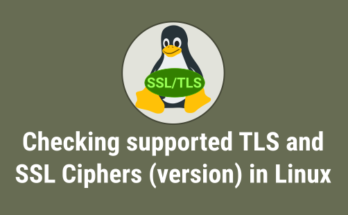About a week ago, I discussed with my friend some Linux topics.
At the time, he told me that he didn’t find a proper resource to find information about Linux command acronyms.
I did a little research, but I didn’t find what I wanted about this topic.
So I decided to write an article about it.
It may help others who are looking for this information. We have added a very small number of acronyms at this time.
But I can say for sure, over the period of time, we will load a dozen of abbreviations. So I urge you to stay on this page.
Also, if you would like to contribute to this article I would request you to update the information about acronyms in the comment section.
We are very happy to update this on your behalf.
Linux Package Manager:
Commands Description yum Yellowdog Updater, Modified dnf Dandified yum rpm Red Hat Package Manager apt Advanced Package Tool dpkg Debian Package YaST Yet another Setup Tool
File Transfer Commands:
Command Description cp copy scp Secure Copy rsync Remote Sync pssh Parallel Secure SHell dsh Distributed Shell or Dancer’s Shell ftp file transfer protocol sftp secure file transfer protocol dd Data Duplicator mv move
Linux Filesystem Commands:
Command Description fdisk fixed disk or format disk Parted PARTition and EDitor cfdisk curses fdisk df Disk free du Disk usage fsck file system consistency check fstab file system table UUID Universally Unique IDentifier of a partition mkfs make filesystem RAID Redundant Array of Independent Disks or Redundant Array of Inexpensive Disks. udev userspace /dev ASM Automatic Storage Management NFS Network file system lsblk List block devices fs Filesystem SAN storage area network scsi Small computer standard interface LVM logical volume management
Linux Text Processing:
Command Description vi visual vim vi improved awk Aho, Weinberger, Kernighan (names of program authors) emacs editing macros fgrep fixed-string grep egrep extended grep grep global regular expression print rm remove umask user’s (file creation) mask sed stream editor wc word count xargs extended arguments nl number lines cat Concatenates
Linux File and Directory Management:
Command Description mkdir make directory rmdir Remove directories, if they are empty tar tape archive chown Change Owner chmod Change Mode chgrp Change Group pwd Print working directory cd/chdir Change directory inode index node ls list sbin system binaries or superuser binaries setfacl set file access control lists getfacl get file access control lists chcon change context (SELinux)
Linux User Management:
Command Description id identity umask user mask su substitute user or Switch User or superuser sudo substitute user or super user or switch user GID group identification UID user identification SUID set user ID SGID set group ID ulimit user’s limit utmp temporary file with user information
Linux Process Management:
Command Description PID process identification number PPID Parent Process identification number ps process status fg foreground bg background lsof list of open files fuser file user
Linux Network Commands:
Command Description nmap Network Mapper ss Socket Statistics netstat Network Statistics dig Domain information groper IP Internet protocol TCP Transmission control protocol ssh secure shell telnet terminal over network rlogin remote login rexec remote execution NIC Network interface card NTP Network time protocol telnet Terminal over network DHCP Dynamic host configuration protocol LAN Local area network MAC Media access control MTU Maximum transmission unit SNMP Simple network management protocol VPN Virtual private network WAN Wide area network WAP Wireless access point/Wireless application protocol
Linux Hardware Information:
Commands Description lsusb List USB devices lspci List all PCI devices lsscsi List Small Computer System Interface (SCSI) devices vm Virtual memory dmidecode Desktop Management Interface Decode lshw List Hardware hwinfo Hardware Information wwn World Wide Name wwid World Wide Identifier dev devices uname Unix name
Type of Linux Shells and Information:
Command Description sh Bourne shell bash GNU Bourne-Again Shell ksh Korn shell csh C shell Fish Friendly interactive shell chsh Change shell rsh remote shell
Linux General Command :
Command Meaning sar System Activity Report bc basic calculator cal calendar man manual nslookup name server lookup dig Domain Information Groper
Linux General Acronym
Acronym Meaning GRUB GRand Unified Bootloader DNS Domain Name Service or Domain Name System FQDN Fully qualified domain names DE Desktop Environment GUI Graphical User Interface CLI Command Line Interface UI User Interface LILO Linux Loader SELINUX Security Enhanced Linux SSL Secure Sockets Layer LAMP Linux, Apache, MySQL, PHP LAMPP Linux, Apache, MySQL, PHP and PERL http Hypertext Transfer Protocol https Hypertext Transfer Protocol Secure PHP Hypertext Pre-processor init initialization BSD Berkeley Software Distribution (originally Berkeley Source Distribution) CDROM compact disc read-only memory CUPS common UNIX printing system CPU central processing unit RAM Random access memory daemon disk and execution monitor* FOSS free open source software FSF Free Software Foundation GCC GNU Compiler Collection (originally GNU C Compiler) GIMP GNU Image Manipulation Program GNOME GNU Network Object Model Environment KDE K Desktop Environment HFS hierarchical file system I/O input/output ACL Access Control List JVM Java virtual machine LFS Linux From Scratch MBR master boot record PAM pluggable authentication modules GPG GNU Privacy Guard RDBMS relational database management system RHCE Red Hat Certified Engineer SMTP simple mail transfer protocol SMB server message block TTY teletype terminal PTY pseudo-teletype X X Window System tmp temporary xdm X display manager #! Shebang
Wrapping Up
In this guide, we have included possible Linux acronyms and their meaning for your reference purpose and we hope it will be very useful.
If you have any questions or feedback, feel free to comment below.




Is there any explication for “echo”
Hi Ranjith,
Not yet in this site, we will add soon.
THANK YOU so much for this! I am new to Linux, and I am trying to teach myself more about using the command line. I can tell it is a faster, more powerful alternative to “point and click” with the mouse, for many tasks.
Having all these commands in a well-organized fashion is a big help to me. Thank you. ( :
@Kenny,
Thanks for notifying us, We added Acronyms which you suggested.
DE stands for Desktop Environment,
and I remember GUI stands for Graphical User Interface and UI stands for User Interface.